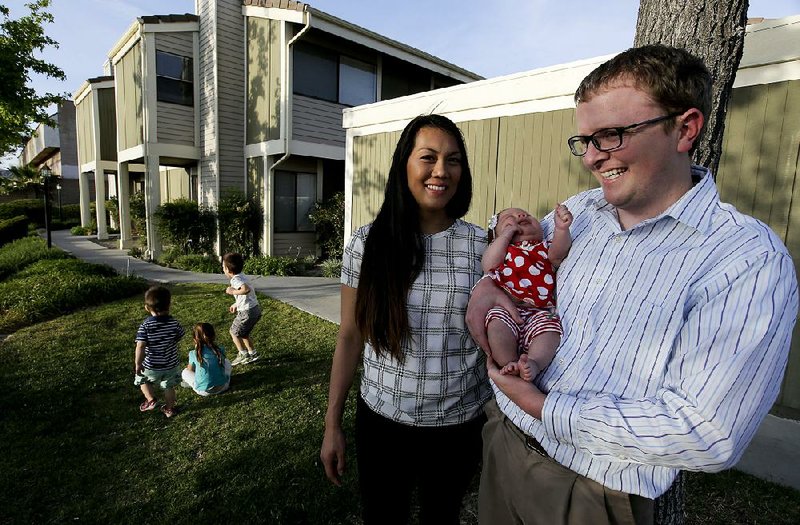Young people aspiring to buy their first homes are already facing disappointment this year.
Rising prices are putting more homes out of their reach, and pickings are slim because few properties have been put on the market this spring, a season when sales normally take off.
Millennials are also burdened with school debt and depleted savings that hurt their ability to qualify for mortgages. Until their incomes start to rise significantly, many will have to delay their dreams of home ownership. This has weighed on overall home sales and economic growth throughout the rebound in housing the past three years.
"People need to see more money in their paychecks before they'll take the plunge into homeownership," said Greg McBride, chief financial analyst at Bankrate.
If early signs are any indication, there won't a noticeable jump in new homeowners this spring.
Amy Arnold and her husband began looking at listings in Denver late last year. The 28-year-old apparel buyer quickly found that the few homes in the couple's price range got snapped up for more than the asking prices, leaving her exasperated over the "crazy" market.
For now, the two have decided to keep renting a two-bedroom, one-bath house for $1,300 a month, hoping that they'll have more money and find a better selection of homes once they resume house-hunting later.
"It's very discouraging," she said. "Hopefully, next year we will be able to buy, but there's a chance we may have to rent again."
Home prices nationwide have risen at more than double the pace of average hourly wages, making it harder for buyers to save for down payments.
In Denver, a limited number of for-sale houses has fueled rising prices and given sellers the upper hand. Forty percent of homes sold in February went for more than the asking price, according to online real estate broker Redfin. That's up from 21 percent a year earlier. In addition, half of the homes were put under contract within eight days of going on the market.
"Typically, January, February, even March are not quite as highly competitive as when you go into the spring months," said Ilona Botton, a Redfin agent in Denver. "That's not how it was this year. It has been multiple-offer situations every single month."
The limited supply of homes is widespread. In March, one measure showed that it would take fewer than five months to sell all the previously occupied homes in the U.S. In a market more balanced between buyers and sellers, it would take about six months, according to the National Association of Realtors.
What's more, high demand for low-priced homes means their prices are rising faster. The cost of homes priced at $135,000 or less jumped 9 percent for the year ending in February, according to data from CoreLogic. The cost of homes priced at $226,800 or more climbed 5 percent over the same period.
Beyond offering more money for homes, some buyers are willing to waive home inspections or give sellers several weeks to move out after a sale, Botton said.
In general, areas with fewer homes for sale have stronger job growth that's eclipsing the pace of construction. Areas with larger inventories tend to keep the availability of housing in line with job growth.
In Columbus, Ohio, aviation company executive Ryan Holtmann had plenty of options. He and his wife started shopping for their first home at the end of last year. The couple visited 15-20 houses before buying a three-bedroom home for $154,900 at the end of February.
"I was really surprised at how much was out there for the time of year," said Holtmann, 33. "There were three or four we liked and would have been more than happy to go with."
One factor preventing more houses from hitting the market is that many homeowners still owe more on their mortgages than their homes are worth. That's known as an underwater mortgage, or being in negative equity.
While millions of homes have returned to positive equity as values come back, some 5.4 million, or 10.8 percent, of all homes with mortgages, remained underwater as of the October-December quarter, according to CoreLogic. Nevada topped the list of such homes. Nearly a quarter of homes with mortgages there were underwater.
More construction would help buyers, but building has moved slowly since 2010. That's one reason a recent report by mortgage buyer Freddie Mac forecast that the U.S. housing market will continue to see low numbers of homes for sale for the next several years.
As a result, even successful buyers are settling for less.
Brett Singley, a first-time buyer in Los Angeles and a father of four, knew the kind of house he wanted and how much he could afford. But after six months of searching, the civil engineer shifted his sights to smaller and less expensive townhomes. In March, he bought one in Santa Clarita, a northern suburb. He got a three-bedroom townhome for just under $300,000 -- $100,000 less than what he was prepared to pay for a house.
"We were originally looking for a four-bedroom house," said Singley. "But we didn't have a lot of options."
SundayMonday Business on 05/17/2015
